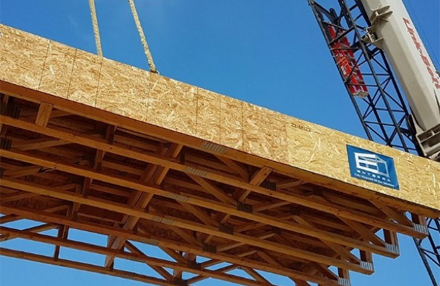Offsite construction is gaining traction as more companies work to make construction more efficient and safer. Although, while the benefits of offsite construction methodology, such as reducing construction times, more consistent builds and improving safety onsite is acknowledged, evidence-based research about these benefits has been lacking. Source: Built Offsite
Ryan Smith is looking to change that.
Mr Smith, director of the University of Utah’s Integrated Technology in Architecture Centre (ITAC), which performs market research and project R&D support for industry performed two global studies.
The first compared permanent modular construction to traditional site builds regarding cost and schedule performance.
“For the cases analysed, modular represented a 16 percent reduction in cost and 45 percent time saving. In a similar study, mass timber construction was compared with traditional site builds to reveal that across 18 cases, mass timber [had] 4 percent less cost and [was] 20 percent faster in delivery,” Mr Smith said.
Mr Smith said the study was carried out was because although the benefits of offsite construction have been widely touted for decades, but there was little quantifiable evidence to back it up.
“This study worked to reveal these benefits. Just as important, however, is the qualitative data that suggests that the greatest challenges the construction industry is facing in adopting offsite methods includes difficulties with the regulatory authorities, transportation logistics, coordination with designers, and industry knowledge,” Mr Smith said.
And although the research was not compared to traditional construction, Mr Smith said the data gathered on both modular and mass timber illustrates the benefits of offsite construction’s fewer safety incidents per project.
“These studies also collected qualitative responses from project stakeholders that have worked with modular construction to determine the key lessons learned, benefits, barriers, and key collaboration tactics for project success,” he said.
This push towards offsite construction has come about due to an industry that has fewer labourers from all stages of construction as a result of the recession, according to Mr Smith.
Despite this, construction demand is increasing, and meeting these demands with the benefits of offsite construction can help to fill the gap currently being experienced in nearly every region of the world.
“Owners are seeing benefits in utilising a factory-based labour force that is consistent and skilled to accomplish its production cycles,” Mr Smith said.
“The productivity associated with offsite construction and benefits on schedule, cost, worker safety and quality is getting noticed.”
But offsite construction is not without its challenges.
The Centre for International Economics pointed to limited knowledge about offsite manufacturing in the Australian construction industry and resistance from advisory councils in its ‘Future forecasts: Construction and Property Services Skills 2016–26’ report.
“Offsite construction has been covered in the media quite frequently as of late. Sometimes this is negative and based on one case leading to misperceptions about prefabrication,” Mr Smith said.
“Offsite needs to grow from a cottage industry to being a viable legitimate construction method option among all of the other options available. In order to do this, not only does the traditional construction industry need to become more educated and knowledgeable about offsite methods for design, but perhaps more importantly, manufacturers must become astute at traditional construction.”
This includes a willingness to take on risk associated with fabricating and installing turn-key solutions.
Mr Smith said each country around the world is dealing with offsite construction in its own way, and each have their own strengths.
For example, Japan is building timber kits and steel modular homes. Meanwhile, Scandinavia and Germany are focusing on mass timber and panelised construction, and the US and Canada are modular driven as a product of the mobile home industry.
“What is fascinating is the relationship between the technologies being implemented and the socio-cultural context in which they emerge,” Mr Smith said.
“What works in one context does not necessarily [work] in another for a myriad of quantifiable and non-identifiable reasons. Sometimes it is as simple as poor weather + expensive labour + expensive land = offsite construction. While other times this equation does not entirely hold.”
He is hoping to impart knowledge about offsite construction implementation to help deepen understanding.
“Knowledge transfer is critical to continue to progress the industry toward more productive means of delivery,” he said.






